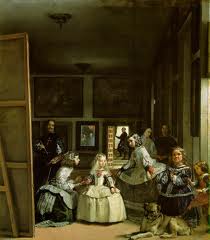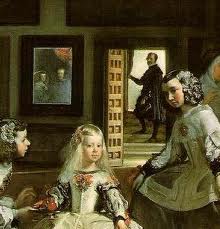Las Meninas
Las Meninas was painted in 1656 by Diego Velázquez and is considered to be one of the best and most intriguing paintings of this era. The painting's composition is highly elaborate and challenges the perceptions of illusion and reality as well as the status and involvement of the subjects and the audience.
The Painting

The painting's setting is Velázquez's studio in the Royal Palace in Madrid. At the time of painting 'Las Meninas', Velázquez had been working for the Spanish Royal Court for over thirty years. He was a highly respected artist by the Royal Family and he often painted pictures of the family members. However 'Las Meninas' was much more unconventional than his other paintings.
The foreground of the painting contains the one of the main focuses of the paintings, the Infanta Margarita, a five year old princess who was the daughter of the Spanish King, Philip IV and his wife, Mariana. The princess is being waited on by two ladies in waiting or maids. To the right hand side of the princess stand two dwarves and a dog. Behind them you can find Margarita's chaperone and a bodyguard.
Velázquez himself is painted in the left hand side of the painting, painting at an easel. A set of keys is hanging from Diego's belt, showing that he was important enough to merit keys to the Court and its offices. The red cross that is situated on his chest, which signifies that he was a member of the Order of Santiago, was added to the painting later, some say by the King himself.
In the background of the painting there are yet more figures of interest. The man stood in the doorway is Don José Nieto Velázquez who was at the time the Spanish queen's chamberlain. He is depicted stood on the stairs although it is not known whether he is entering or leaving the scene.
There is a mirror situated on the back wall of Velázquez's studio which is showing the reflection of two figures, which have been identified by art historians at the Spanish King and Queen from comparisons with other Velázquez paintings. It is thought therefore that these are the subject of the work that Velázquez is painting in 'Las Meninas'.
It is clear that, as there is so much going on in the painting, that it is unclear as to whom or what the real subject is. It could be the princess, the king and queen, Velázquez, or even the audience of the painting. To date, art historians and critics are still in disagreement over the view point of the painting.

The composition and technique of Velázquez has therefore been celebrated and studied for many years. Although the canvas was divided into a grid, as was conventional at the time, the focal point of 'Las Meninas' is what makes it so intriguing. Steinberg believes that some of the orthogonals in the painting are hidden by Velázquez so as to shift the focal centre of the painting.
Perspective is a key element of 'Las Meninas'. Diego Velázquez uses linear perspective, tone and overlapping shapes in order to create the feelings of depth in the painting. The use of light also helps to highlight the different focal points of the picture as well as adding defintion to the subjects.
History
'Las Meninas' was originally referred to as 'La Familia' in the Royal Court inventories. The painting has survived over the years, mostly thanks to the efforts of many restorers. The painting was damaged during the fire in the palace of 1734 and was later restored by Juan García de Miranda, another Spanish Royal Court painter. Juan García de Miranda had to repaint the entire left cheek of the princess as it had been so badly damaged.
The painting remained part of the Royal Collection until 1819 when it was acquired by the Prado Museum. It was here in 1843 that the painting came to be known as 'Las Meninas'. The painting has often been restored and cleaned to try and stop it from ageing too much. The painting is considered to be so important and so valuable that it never leaves the museum. Therefore you can only see this painting in Spain.
